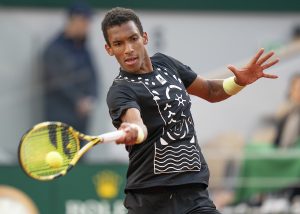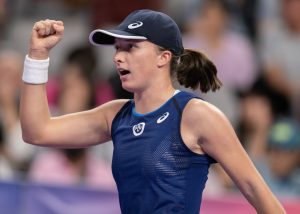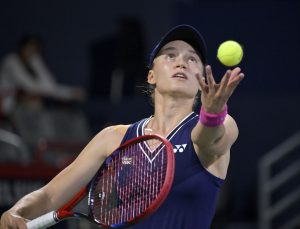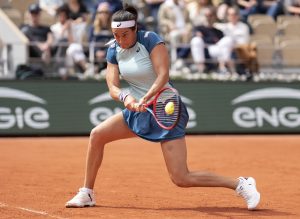With Finals Weekend upon us, our resident tennis historian, Martin Keady, looks back at the five finest Australian Open Men’s Singles Finals.
This year’s Australian Open semi-finals may have been damp squibs, with both Kyle Edmund and Hyeon Chung suffering from injuries (in Chung’s case to the point where he had to retire early), but the final between Roger Federer, the defending champion, and Marin Cilic, arguably the tournament’s form player, promises to be anything but. Although their first Grand Slam Final at Wimbledon last summer was a straight sets victory for Federer, when Cilic himself was injured, it is highly unlikely that Sunday’s Final will be equally straightforward, as Cilic is fully fit, firing on all cylinders and – perhaps crucially – will have enjoyed three days of rest before the Final.
Whatever happens on Sunday, though, it will have to be pretty amazing to produce a Final as good as those on this list. Here, then, are the Five Finest Australian Open Men’s Singles Finals.
- 1960: ROD LAVER BEATS NEALE FRASER (5–7, 3–6, 6–3, 8–6, 8–6)
Fittingly, the first two entries on this list are all-Australian affairs, because for much of its history the Australian Championship (as it was before the advent of the Open era in tennis in 1968) was dominated by home players. The finest male Australian player of them all, of course, was Rod Laver, but in 1960 he had yet to prove that was the case. Indeed, that year, as he competed in only his second Major Final (he had lost the 1959 Wimbledon final to Peru’s Alex Olmedo), the favourite to win the match was the man on the other side of the net, Neale Fraser.
Fraser is often the forgotten man of Australian tennis, but that is only because of the extraordinary achievements of so many other great Australian male players, notably Laver, Roy Emerson and Ken Rosewall. Nevertheless, when Fraser faced Laver in the Melbourne final in 1960, he was the only man on court who had already won a Major, having triumphed at the US Championship in 1959. As a result, it was generally felt that his superior experience would win the day against Laver, who was five years younger than him.
That certainly appeared to be the case when Fraser won the first two sets, 7-5 and 6-3. Laver, however, soon showed that he possessed not only incredible ability but intestinal fortitude. He fought back from two sets down and even survived a match-point in the fourth set before finally winning in five sets. Fraser would recover sufficiently to win two more Majors that year (Wimbledon, and the US Open again), but ultimately Laver would surge past him in the all-time stakes, winning a total of 11 Majors, including the calendar Grand Slam twice, in 1962 and 1969.
- 1965: ROY EMERSON BEATS FRED STOLLE (7–9, 2–6, 6–4, 7–5, 6–1)
There are obvious similarities between the 1960 and 1965 Australian Open Men’s Finals. Both were contested by two home players; in the era before the invention of the tie-break in 1971, both were long, hard-fought five-setters; and, most importantly, in both finals the eventual winner had to fight back from being two sets down.
Roy Emerson had filled the hole left in Australian men’s tennis when Rod Laver turned professional in 1962, which had rendered Laver ineligible to compete in the Majors, including the Australian Open. The two men had actually contested two Australian Open Finals before Laver turned professional, winning one apiece, but when Laver went to play on the professional circuit in North America, the path was open for Emerson to dominate the Australian Championships. He won five Australian titles in a row between 1963 and 1967, but the finest of all those finals was the 1965 edition, when he beat yet another great Australian player, Fred Stolle, in one of the greatest Melbourne finals of them all.
Rather like Neale Fraser, Fred Stolle is often overlooked today when the names of the great Australian Champions of the past are mentioned, but like Fraser he was a Major winner, having won the French Open earlier in 1965. And when he faced Emerson in the Australian Open Final at the end of the year, he was intent on avenging his loss to him in the 1964 final. He had lost that final rather meekly, in straight sets, but in 1965 he immediately showed that he would not go down so easily by taking the first two sets. However, Emerson, like seemingly all the great Australian tennis players (both male and female), was never one to give up and he fought back superbly to win the next two sets.
Thus, the stage was set for a deciding fifth set, but unfortunately it never materialised, as Emerson raced away from Stolle to win 6-1. Nevertheless, despite the anti-climax of the final set, the four sets that preceded it were of sufficient quality to earn the 1965 final fourth place on this list.
- 1988: MATS WILANDER BEATS PAT CASH (6–3, 6–7 (3–7), 3–6, 6–1, 8–6)
For the last three decades of the 20th century, men’s tennis had a third superpower to go alongside the traditional giants of America and Australia, as Sweden suddenly produced a succession of great players. The production line began, of course, with Bjorn Borg but it also encompassed the likes of Stefan Edberg, Thomas Johansson (the last Swedish winner of a Slam, at Melbourne in 2002) and Robin Soderling, who was the first man ever to beat Rafael Nadal at the French Open and might have gone on to win a Major if he had not contracted glandular fever and been forced to retire.
Mats Wilander was the second most successful Swedish man after Borg, winning eight Majors to Edberg’s six, and three of those eight were won in Melbourne. He first triumphed in Australia in 1983, when he beat Ivan Lendl in the final in straight sets (before Lendl became a serial Major winner himself), and retained the title the following year against South Africa’s Kevin Curran. However, it is his third and final Australian triumph, in 1988, that will live longest in the memory.
1988 was the year that the Australian Open switched from grass to hardcourt, and there must have been many times since when the organisers have rued that decision, as it effectively stripped Australian players of the surface that they had traditionally excelled on. Wilander’s opponent in the final that year was one of the last great Australian serve-volleyers, Pat Cash, who had won Wimbledon the previous year and seemed set to become the first Australian man to win in Melbourne since the relatively unheralded Mark Edmondson had triumphed in 1976.
The match was a classic clash of styles, with Wilander the baseliner facing a genuine “net-rusher” in Cash. It ebbed and flowed for more than four hours before Wilander finally won 8-6 in the fifth to claim his third and final Australian title. Given how hard Cash had pushed him on a hardcourt, he must have always wished since that the Australian Open organisers had waited at least another year before making their fateful decision to switch from grass.
- 2017: ROGER FEDERER BEATS RAFAEL NADAL (6–4, 3–6, 6–1, 3–6, 6–3)
Sadly, Rafael Nadal’s retirement in his quarterfinal against Marin Cilic earlier this week robbed Melbourne of the chance of a rematch of the epic 2017 final that he had contested against Roger Federer. However, even if he had made it through to the final to face the Swiss again, it is highly unlikely that it could have matched the extraordinary final of 2017.
Both Federer and Nadal, who had dominated tennis for so long before Novak Djokovic finally broke their iron grip on the game, had actually spent the six months before the 2017 Australian Final recovering from what appeared to be career-threatening injuries. Thus it was that the whole tennis world rejoiced in the renewal of their great rivalry when they somehow turned back time and fought their way through to the men’s singles final in Melbourne.
What followed was a match that was not quite of the unmatchable quality of their 2008 Wimbledon Final, which might be the greatest men’s tennis match ever, but it was still absolutely outstanding, not least because most tennis fans and writers had thought that the pair’s best days were finally behind them. But the Spanish Wall and the Swiss Prince were determined to prove otherwise, as they fought it out over five sets to see who was the greatest champion of them all.
It was only in the fifth set that the match really touched the heights, as it was only in that set that both men played brilliantly at the same time. Before then, they had traded sets, with Federer winning the first and third relatively easily, before Nadal fought back twice to win the second and fourth sets with almost equal ease. However, the fifth set alone was enough to ensure that the match was one for the ages.
Nadal initially went ahead, breaking Federer to go 3-1 up, and it seemed as if the pattern of the previous decade, in which Nadal had won all the Major Finals between the two men, would be continued. But then came the great switch, and it was indeed as if Federer had flipped a switch and turned on the unstoppable tide of his talent, as he won five games in a row to take the title. That was despite the fact that Nadal was still proving almost unbeatable, and certainly unpassable, as he somehow returned a succession of what appeared to be outright winners, before Federer finally triumphed. In the process, he had produced probably the finest single set of tennis in the entire history of the sport, because that is what had been required for him finally to beat his great rival.
- 2012: NOVAK DJOKOVIC BEATS RAFAEL NADAL (5–7, 6–4, 6–2, 6–7 (5–7), 7–5)
The greatest Australian Open Men’s Final of them all is one of the greatest of all Grand Slam Finals. It came in 2012, when Novak Djokovic finally proved beyond doubt that the greatest era in men’s tennis was not just about Roger and Rafa, but that he was the George Foreman to their Ali and Frazier. (The boxing analogy is inevitable, given that it is only the great heavyweight era of the 1970s that bears comparison in all of sport with the splendours of the last decade in tennis.)
Djokovic, of course, had already enjoyed a stellar 2011, when, newly gluten-free and seemingly inspired to individual success after leading Serbia to a first ever Davis Cup win in 2010, he had won three of the four Majors. As Federer seemed to struggle with his own game (relatively speaking, in comparison with his extraordinary achievements in the noughties), it was Nadal who was his only realistic contender for the game’s greatest prizes. That was proved again when the two men contested the 2011 US Open Final. Although Djokovic eventually won, Nadal fought him all the way, and it was only a surprise that the match did not last a full five sets. Instead, it was merely the greatest four-set Major Final that anyone could remember.
However, it was almost instantly forgotten because the next Major men’s final, the 2012 Australian Open Final, was not just a classic five-setter but the longest ever men’s final in the Open era, lasting more than six hours. Nadal won the first set, Djokovic the next two and then the fourth set was decided by a spectacular tie-break, which Nadal eventually won 7-5. Djokovic would go on to win the fifth set by the same score in games, but not before Nadal had almost fought him to a standstill.
This match, alongside the 2008 Wimbledon Final and the 2017 Australian Open Final, is the third in the “Holy Trinity” of Great Men’s Finals of the era, and although the 2008 Wimbledon Final perhaps just shades it for overall quality (and the added bonus of unfolding against a dramatically darkening sky), the 2011 Australian Open Final runs it close. In finally winning it, Djokovic proved beyond doubt that he was the most famous “Third Man” since Harry Lime, and that “The Rubber Man” (he was so nicknamed because of his extraordinary dexterity) rightly ranked alongside The Wall (Nadal) and The GOAT (Federer).
Main Photo:






